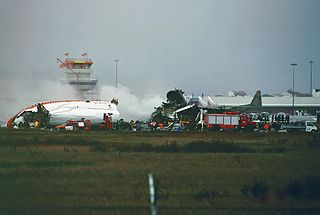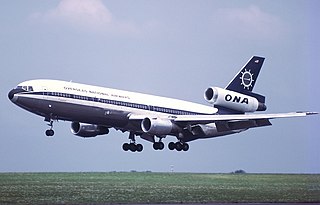
The McDonnell Douglas DC-10 is an American trijet wide-body aircraft manufactured by McDonnell Douglas. The DC-10 was intended to succeed the DC-8 for long-range flights. It first flew on August 29, 1970; it was introduced on August 5, 1971, by American Airlines.
World Airways, Inc. was an American airline headquartered in Peachtree City, Georgia in Greater Atlanta. The company operated mostly non-scheduled services but did fly scheduled passenger services as well, notably with McDonnell Douglas DC-10 wide body jetliners. World Airways ceased all operations on March 27, 2014.
Capitol Air was a charter airline and scheduled passenger air carrier based in the United States which was operational from 1946 to its bankruptcy filing on November 23, 1984. It was founded as Capitol Airways in 1946, and then renamed Capitol International Airways in 1967. In 1981, the airline changed its name to Capitol Air and was operating scheduled domestic and international passenger flights that year.

The original Overseas National Airways Inc (ONA) was an American airline, formed in June 1950 as a supplemental air carrier. It ceased operations on September 14, 1978. The airline started as Air Travel in 1946 and was renamed Calasia Air Transport the same year. The name changed to Overseas National in 1950 when it became a supplemental air carrier.
Spantax S.A. was a Spanish leisure airline headquartered in Madrid that operated from 6 October 1959 to 29 March 1988. Spantax was one of the first Spanish airlines to operate tourist charter flights between European and North American cities and popular Spanish holiday destinations and was considered a major force in developing 20th-century mass tourism in Spain. Its popularity and image faded from the 1970s onward when a series of crashes and incidents revealed safety deficits, which, combined with rising fuel costs and increasing competition, resulted in the company facing severe financial difficulties that led to its demise in 1988.

Daytona Beach International Airport is a county-owned airport located three miles (5 km) southwest of Daytona Beach, next to Daytona International Speedway, in Volusia County, Florida, United States. The airport has 3 runways, a six-gate domestic terminal, and an international terminal. Daytona Beach is the headquarters of Embry-Riddle Aeronautical University.

The McDonnell Douglas DC-9 is an American five-abreast, single-aisle aircraft designed by the Douglas Aircraft Company. It was initially produced as the Douglas DC-9 prior to August 1967, after which point the company had merged with McDonnell Aircraft to become McDonnell Douglas. Following the introduction of its first jetliner, the high capacity DC-8, in 1959, Douglas was interested in producing an aircraft suited to smaller routes. As early as 1958, design studies were conducted; approval for the DC-9, a smaller all-new jetliner, came on April 8, 1963. The DC-9-10 first flew on February 25, 1965, and gained its type certificate on November 23, to enter service with Delta Air Lines on December 8.

Martinair Flight 495 was a McDonnell Douglas DC-10 operated by Dutch airline Martinair, that crash-landed in severe weather conditions at Faro Airport, Portugal on 21 December 1992. The aircraft carried 13 crew members and 327 passengers, mainly holidaymakers from the Netherlands. 54 passengers and 2 crew members died. 106 of the other occupants were badly injured.

Northeast Airlines was an American airline based in Boston, Massachusetts that chiefly operated in the northeastern United States, and later to Canada, Florida, the Bahamas, Los Angeles and other cities. It was acquired by and merged into Delta Air Lines in August 1972.

In aviation, a water landing is, in the broadest sense, an aircraft landing on a body of water. Seaplanes, such as floatplanes and flying boats, land on water as a normal operation. Ditching is a controlled emergency landing on the water surface in an aircraft not designed for the purpose, a very rare occurrence. Controlled flight into the surface and uncontrolled flight ending in a body of water are generally not considered water landings or ditching.
National Airlines was a major airline in the United States that operated from 1934 to 1980, when it merged with Pan Am. For most of its existence the company was headquartered at Miami International Airport, Florida. At its height, National Airlines had a network of "Coast-to-Coast-to-Coast" flights, linking Florida and Gulf Coast destinations such as New Orleans and Houston with cities along the East Coast as far north as Boston as well as with large cities on the West Coast including Los Angeles, San Francisco and Seattle. From 1970 to 1978, National, Braniff International Airways, Pan American World Airways and Trans World Airlines (TWA) were the only U.S. airlines permitted to operate scheduled passenger flights to Europe.

Viasa Flight 742 was an international, scheduled passenger flight from Caracas, Venezuela to Miami International Airport with an intermediate stopover in Maracaibo, Venezuela that crashed on 16 March 1969. After taking off on the Maracaibo to Miami leg, the McDonnell Douglas DC-9-32 hit a series of power lines before crashing into the La Trinidad section of Maracaibo. All 84 people on board perished, as well as 71 on the ground.

Cubana de Aviación Flight 1216 was a McDonnell Douglas DC-10 that overran the runway at La Aurora International Airport, Guatemala City, on 21 December 1999. 36 passengers and five crew members on board were killed as well as seven people on the ground.

Iberia Flight 933 was an international flight from Madrid Barajas International Airport bound for its destination, Boston-Logan International Airport in Boston that suffered a crash landing on December 17, 1973. As the McDonnell Douglas DC-10 operating the flight was approaching the airport, it collided with the approach lighting system (ALS) 500 feet short of the runway threshold. The impact broke off the right main landing gear. The aircraft became airborne for about 1,200 feet, then landed on runway 33 Left, veered to the right off the runway and came to rest. All 168 on board survived, but the plane was written off. This accident was the first hull loss of the DC-10.

Overseas National Airways (ONA) Flight 032 was a non-scheduled positioning flight operated by Overseas National Airways with a McDonnell Douglas DC-10-30CF. On November 12, 1975, the flight crew initiated a rejected takeoff after accelerating through a large flock of gulls at John F. Kennedy International Airport, resulting in a runway excursion. Of the 139 aircraft occupants, all survived, while the aircraft was destroyed by an intense post-crash fire. The National Transportation Safety Board concluded that the probable cause of the accident was bird ingestion into the right-hand engine, causing an uncontained engine failure that ruptured several landing gear tires and disabled the engine's hydraulic system, in turn partially disabling the spoilers and the landing gear brakes. Contributing to the accident was the resultant failure of the affected engine's thrust reverser and the wet runway. The accident aircraft is claimed to be the largest commercial airliner ever destroyed due to a bird strike.












